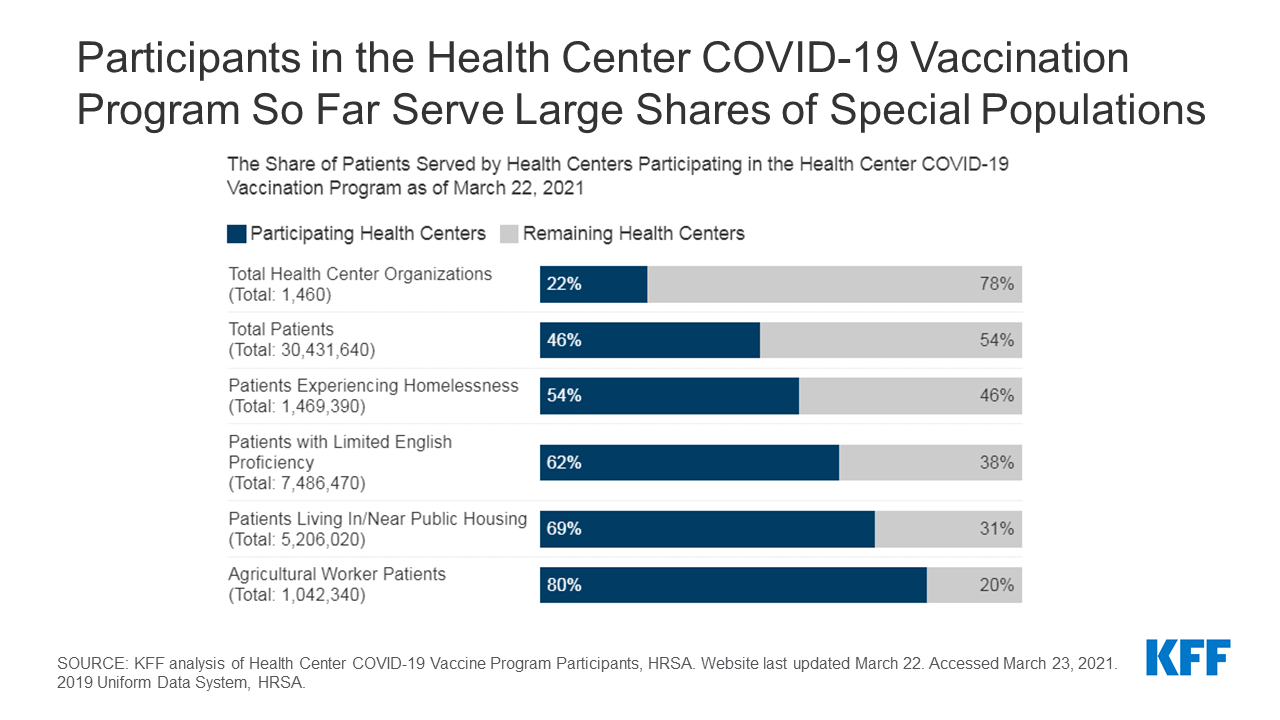
As part of the Biden administration’s plans to facilitate more equitable access to vaccinations, the administration has formed a partnership with community health centers, known for providing health care to some of the hardest-to-reach populations. This partnership, called the Health Center COVID-19 Vaccination Program, directly supplies health centers with a limited number of doses to increase vaccinations among people of color, low-income communities, and other underserved populations that make up a large share of health center patients. The first phase of the program kicked off February 15, 2021 and invited 250 health centers to participate, aiming to provide them with 1 million vaccine doses over the course of 4 weeks. Currently, the program is in the process of adding 700 more health centers, phasing in participation over a period of six weeks, and, by May, the administration expects to open the program to all 1,400 health center organizations across the U.S.
As of March 22, 2021, there were 325 health centers participating in the Health Center COVID-19 Vaccination Program and they had received over 1 million vaccine doses. Based on 2019 data, 75% of all patients visiting these health centers were people of color and 92% had incomes at or below 200% of the federal poverty level. Prior KFF research has shown that health centers are vaccinating people of color at higher rates than vaccine efforts nationally, and that is especially true for health centers participating in the federal program where, according to federal officials, over 65% of the allocated doses have been administered to people of color.
The first 325 health centers to participate in the program have the capacity to reach very specific, high-need populations that may require more resource-intensive vaccination efforts. Many of the health centers participating in the early phase of the program receive designated funding to treat agricultural workers, patients experiencing homeless, and/or patients living in or near public housing. They are also larger, on average, than other health centers. Our analysis shows that these health centers served just under half of all health center patients in 2019, as well as 80% of all health center patients who are agricultural workers, 69% of all patients living in or near public housing, 62% of patients with limited English proficiency, and just over half (54%) of patients experiencing homelessness (Figure 1). Although health centers provide services to only a subset of these individuals, reaching high-need populations as well as others facing barriers to vaccinations in the greatest numbers possible will be helpful in achieving population-level immunity.
Although the Health Center COVID-19 Vaccination Program represents a small portion of vaccinations nationally to date, increased federal funding for the program will enable participating health centers to reach many more people. On March 25, 2021, the Biden administration announced $6 billion in federal funding from the American Rescue Plan would be directed to health centers to expand vaccine access. This investment, coupled with new flexibility allowing health centers to vaccinate people in ACIP’s Phase 1c priority group along with other state priority populations, will enable health centers to reach more of their patients and other higher-risk individuals in their communities. Currently, the program is onboarding 700 more health centers as part of the second phase of the program, including those serving large shares of people with low incomes and people of color, those located in rural and frontier areas, those serving tribal communities, and health centers operating mobile vans with the ability to take vaccinations out into the community. Ensuring more equitable access to the COVID-19 vaccine will be a meaningful step in mitigating the disparate impacts of the pandemic and limiting health disparities in the future.
| Methods |
| For this analysis, we matched health centers listed on the Health Center COVID-19 Vaccine Program Participants web page with data from the 2019 Uniform Data System (UDS). We also used data from data.HRSA.gov to assist with matching health center name, city, and state information. All data presented here include federally funded health centers and look-alike organizations, which meet all Health Center Program requirements but do not receive federal grants under Section 330 of the Public Health Service Act. We accessed the list of health centers on March 23, 2021 and identified 324 participating health centers (of 950 invited health centers). More recent information from HRSA indicates that the number of participating health centers as of March 22, 2021 was 325, and so we were not able to identify one participating health center for our analysis. |
"center" - Google News
March 31, 2021 at 08:05PM
https://ift.tt/3u1NbYu
The Health Center COVID-19 Vaccination Program is Prioritizing Hard-to-Reach Communities - Kaiser Family Foundation
"center" - Google News
https://ift.tt/3bUHym8
https://ift.tt/2zR6ugj
Bagikan Berita Ini














0 Response to "The Health Center COVID-19 Vaccination Program is Prioritizing Hard-to-Reach Communities - Kaiser Family Foundation"
Post a Comment